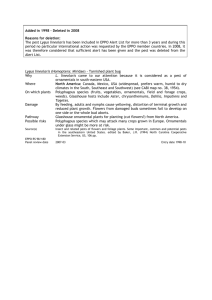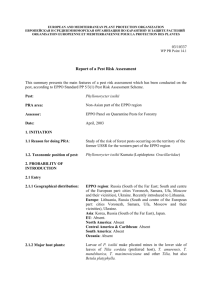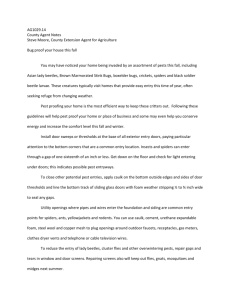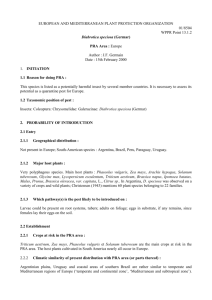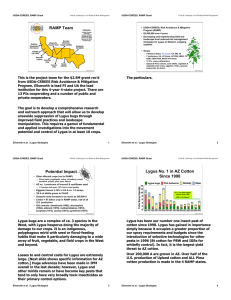EUROPEAN AND MEDITERRANEAN PLANT PROTECTION
advertisement
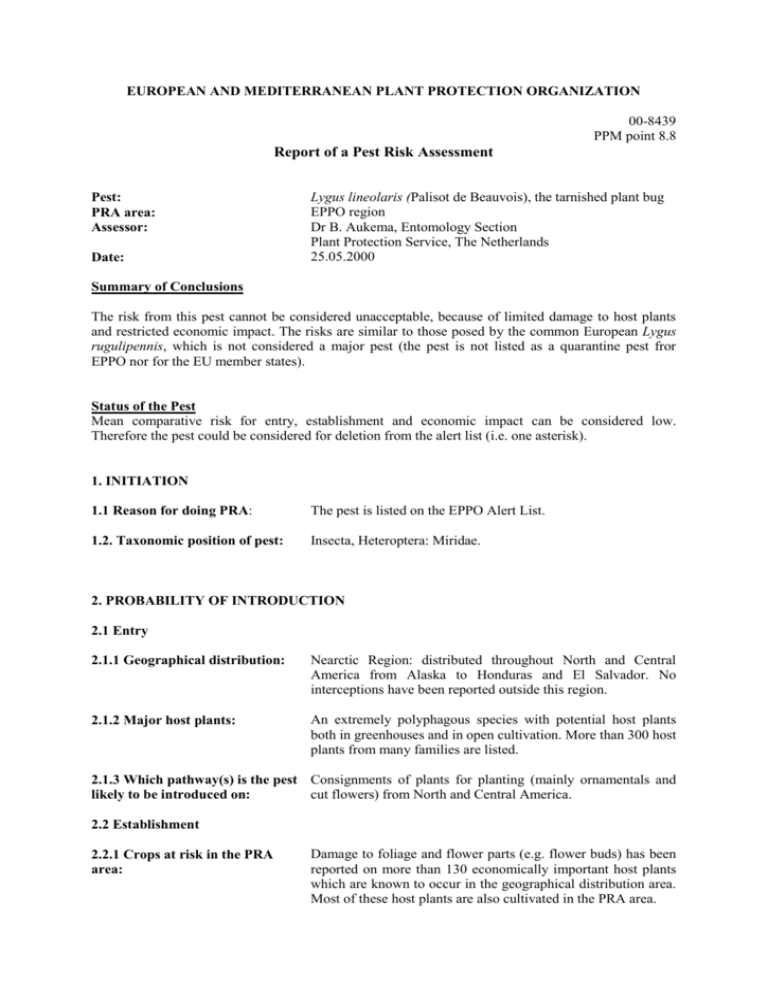
EUROPEAN AND MEDITERRANEAN PLANT PROTECTION ORGANIZATION 00-8439 PPM point 8.8 Report of a Pest Risk Assessment Pest: PRA area: Assessor: Date: Lygus lineolaris (Palisot de Beauvois), the tarnished plant bug EPPO region Dr B. Aukema, Entomology Section Plant Protection Service, The Netherlands 25.05.2000 Summary of Conclusions The risk from this pest cannot be considered unacceptable, because of limited damage to host plants and restricted economic impact. The risks are similar to those posed by the common European Lygus rugulipennis, which is not considered a major pest (the pest is not listed as a quarantine pest fror EPPO nor for the EU member states). Status of the Pest Mean comparative risk for entry, establishment and economic impact can be considered low. Therefore the pest could be considered for deletion from the alert list (i.e. one asterisk). 1. INITIATION 1.1 Reason for doing PRA: The pest is listed on the EPPO Alert List. 1.2. Taxonomic position of pest: Insecta, Heteroptera: Miridae. 2. PROBABILITY OF INTRODUCTION 2.1 Entry 2.1.1 Geographical distribution: Nearctic Region: distributed throughout North and Central America from Alaska to Honduras and El Salvador. No interceptions have been reported outside this region. 2.1.2 Major host plants: An extremely polyphagous species with potential host plants both in greenhouses and in open cultivation. More than 300 host plants from many families are listed. 2.1.3 Which pathway(s) is the pest Consignments of plants for planting (mainly ornamentals and cut flowers) from North and Central America. likely to be introduced on: 2.2 Establishment 2.2.1 Crops at risk in the PRA area: Damage to foliage and flower parts (e.g. flower buds) has been reported on more than 130 economically important host plants which are known to occur in the geographical distribution area. Most of these host plants are also cultivated in the PRA area. 2.2.2 Climatic similarity of present The climate of the entire PRA area is similar to the present distribution area of the pest. distribution with PRA area (or parts thereof): 2.2.3 Aspects of the pest's biology that would favour establishment: Adults fly frequently and there is more than one generation (25) per year. Adults can cover large distances by wind dispersal. Eggs overwinter in woody plant parts and are difficult to detect. 2.2.4 Characteristics (other than climatic) of the PRA area that would favour establishment: There are many host plants throughout the PRA area, and ornamentals are transported throughout the PRA area and are imported from other areas where Lygus lineolaris is known to occur. 2.2.5 Which part of the PRA area is the endangered area: All parts of the PRA area are threatened, because of the wide distribution of host species within the PRA area. 3. ECONOMIC IMPACT ASSESSMENT 3.1 Describe damage to potential hosts in PRA area: Plants suffer from sucking damage to leaves and flower parts (mainly flower buds). There are no reports of plant losses. 3.2 How much economic impact does the pest have in its present distribution: Within crops and nurseries, reported damage is limited. Economic impact to specific crops is restricted because of the highly polyphagous nature of the pest. Incidental damage has been reported from more than 130 economically important plant species. 3.3 How much economic impact would the pest have in the PRA area: The anticipated economic impact is similar to those caused by the related Palaearctic species Lygus rugulipennis Poppius which cannot be considered a major pest. Lygus rugulipennis Poppius not a quarantine pest for EPPO nor for the EU member states. 4. CONCLUSIONS OF PRA 4.1 Summarize the major factors that influence the acceptability of the risk from this pest: The risk from this pest cannot be considered unacceptable because of limited anticipated economic impact. The risks are similar to those posed by the common European Lygus rugulipennis, which is not considered a major pest (the pest is not listed as a quarantine pest for EPPO nor for the EU member states). 4.2 Estimate the probability of entry: 4.3 Estimate the probability of establishment: 4.4 Estimate the potential economic impact: The economic impact will be similar to those of Lygus rugulipennis, which is not listed as a quarantine pest, and can be considered of minor importance.. 4.5 Degree of uncertainty 5. OVERALL CONCLUSIONS OF THE ASSESSOR Sources 1. Gerber, G.H. & I.L. Wie, 1995. Seasonal occurrence and number of generations of Lygus lineoralis and L. borealis (Heteroptera: Miridae) in southern Manitoba. Canadian Entomologist 127: 543-559. 2. Graham, H.M., A.A. Negm & L.R. Ertle, 1984. Worldwide literature of the Lygus complex (Hemiptera: Miridae), 1900-1980. United States Department of Agriculture, Bibliography and Literature 30: 1-250. 3. Handley, D.T. & J.E. Pollard, 1993. Microscopic examination of Tarnished Plant Bug (Heteroptera: Miridae) feeding damage to strawberry. Journal of Economic Entomology 86: 505510. 4. Henry, T.J. & D.J. Hilburn, 1990. An annotated list of true bugs (Heteroptera) of Bermuda. Proceedings of the Entomological Society of Washington 92: 675-684. 5. Kelton, L.A., 1975. The Lygus bugs (genus Lygus Hahn) of North America (Heteroptera: Miridae). Memoirs of the Entomological Society of Canada 95: 1-101. 6. Kelton, L.A., 1982. Plant bugs on fruit crops in Canada. Heteroptera: Miridae. Agriculture Canada Monograph 24: 1-201. 7. Schwartz, M.D. & R.G. Foottit, 1992. Lygus bugs on the prairies: biology, systematics, and distribution. Agriculture Canada Technical Bulletin 1992-4E: 1-46. 8. Schwartz, M.D. & R.G. Foottit, 1997. Revision of the Nearctic species of the genus Lygus Hahn, with a review of the Palaearctic species (Heteroptera: Miridae). Memoirs on Entomology, International 10: I-vii, 1-428. 9. Snodgrass, G.L., W.P. Scott & J.W. Smith, 1984. An annotated list of host plants of Lygus lineolaris (Hemiptera: Miridae) in Arkansas, Louisiana and Mississippi Delta. Journal of the Georgia Entomological Society 19: 93-101. 10. Young, O.P., 1986. Host plants of the tarnished plant bug, Lygus lineolaris (heterodera: Miridae). Annals of the Entomological Society of America 79: 747-762.
